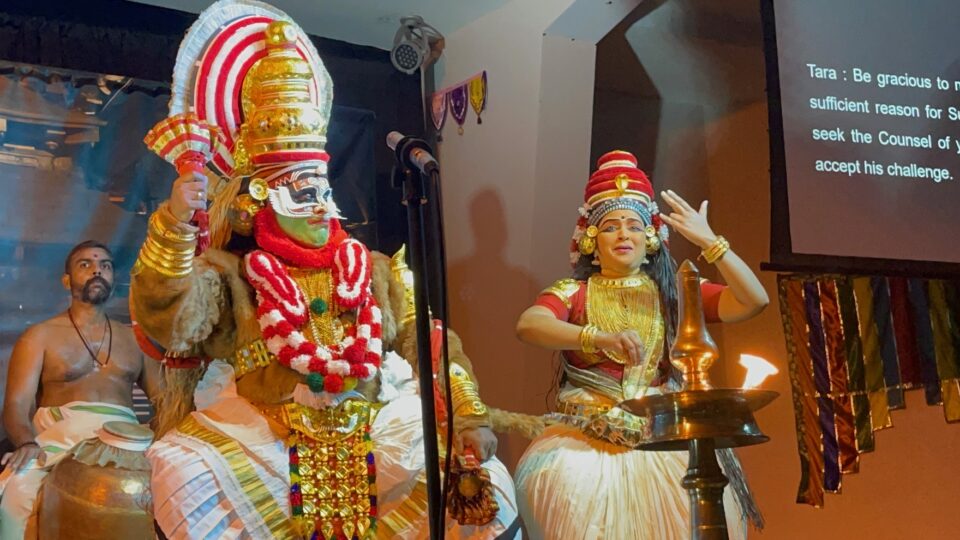BY JYOTHSNA HEGDE
Atlanta, GA, June 30, 2023: ‘Tradition is not the worship of ashes but the preservation of fire,’ composer Gustav Mahler famously said. Connoisseurs of performing arts and traditional dance form aficionados of Atlanta were privy to one of India and the world’s oldest preserved traditions – a 2000-year-old temple art, and the only surviving form of the traditional presentation of Sanskrit drama – Koodiyattam!
The audience watched in awe as the imagery of the Balivadham narrative unfolded through the talent of the Koodiyattam, Nangiar Koothu, and Chakyar Koothu performers of Kerala Kalamandalam. The artists portrayed the characters with twitches of the eyebrows, and movement of the hands and body which resonated perfectly with synchronized sounds of Mizhavu drums in the background, unveiling the unadulterated, magical syzygy of acting, rhythm, and Vedic music.
The unique Kerala Temple Sanskrit theatre, one of India’s oldest living theatrical traditions, was presented in Atlanta by Hindus of Georgia in association with Swasthi Foundation USA on June 9, 2023 at Gokuldham Haveli. Dr. Swati Kulkarni, Consul General of India, Atlanta and Shiv Aggarwal, owner, Global Mall presided as chief guests for the evening.
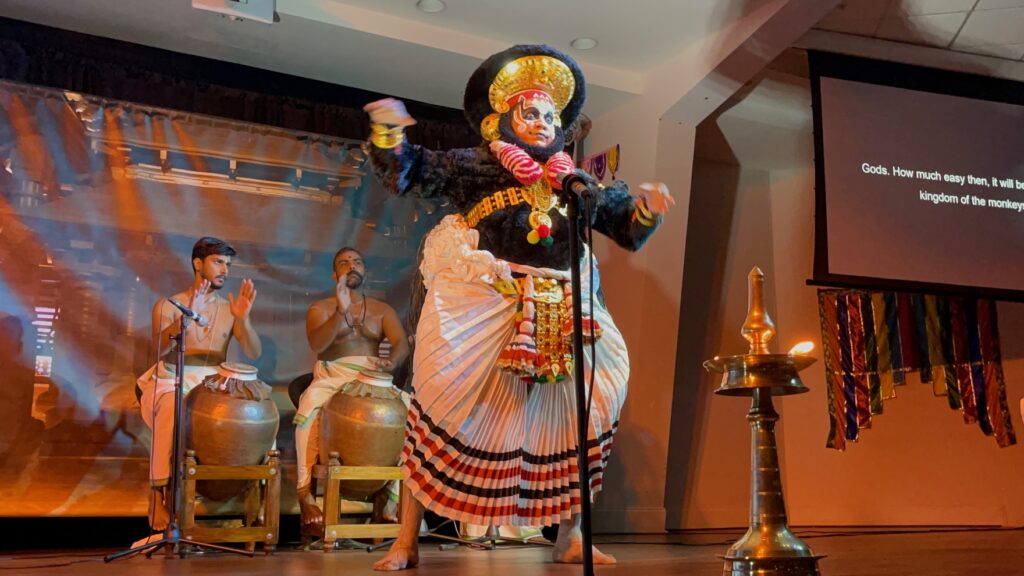
In terms of international theatrical history, Koodiyattam can perhaps claim the greatest antiquity. Dating back about two millennia, Koodiyattam draws on plays of eminent Sanskrit dramatists of India. It is no wonder then, that the art form was declared one of the ‘Masterpieces of the Oral and Intangible Heritage of Humanity’ by UNESCO in 2001.
“Swasthi Fest was envisioned to promote artforms like Koodiyattam, Nagyarkoothu, Chakyarkoothu, all spectacular, but little known to the current generation. By promoting (the art form), not only do we financially support this artist but also enrich, educate and entertain,” Dr. Asha Potti, co-founder of Swasthi Foundation, said.
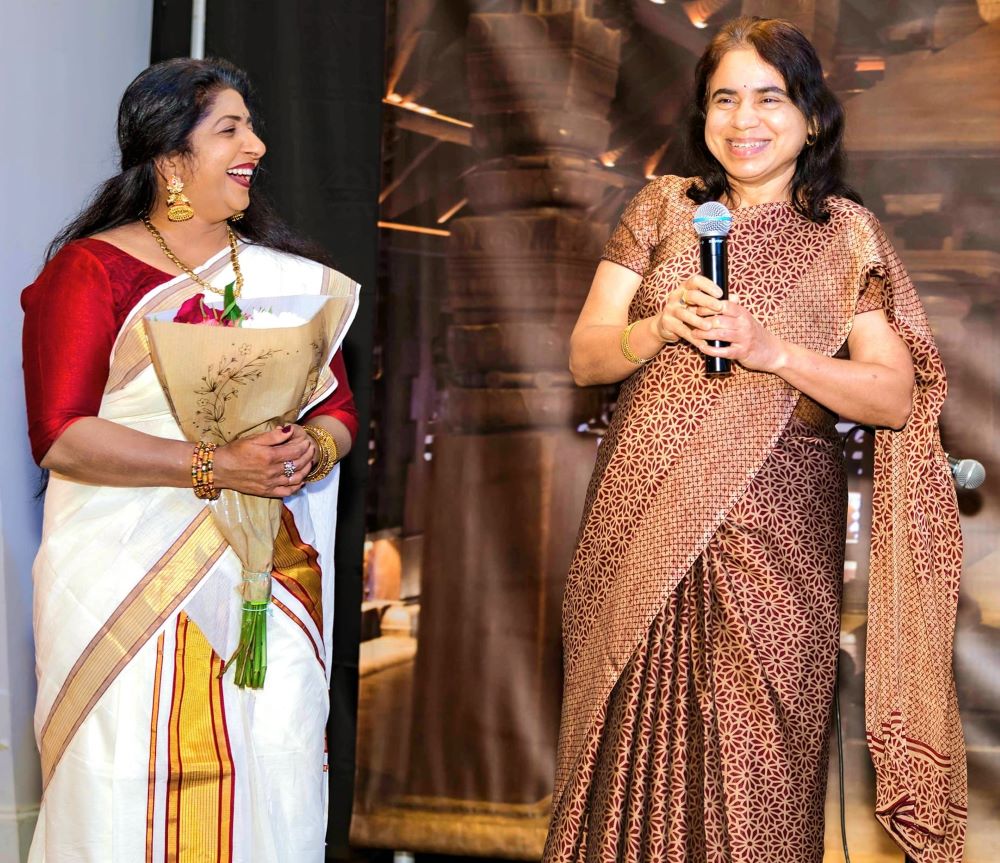
Swasthi Foundation is a nonprofit organization that promotes traditional artforms and folklore. It was founded at the time of the pandemic to support the artists and preserve rich artforms, Dr. Potti said. The artists also performed in several other states.
When a single actor performs multiple roles with an accent on storytelling, it is called Koothu; when a group of artistes, male and female, don various roles, it is called Koodiyattam, which literally translates to “playing or acting together,” referring to the presence of numerous performers on stage who act with the mizhavu drummers’ rhythms. Koodiyattam is performed by a community of male actors called Chakyars and female performers called Nangiars, assisted by drummers called Nambiars.
Traditionally, the chief musical instrument used to accompany Koodiyattam is the Mizhavu, a large percussion instrument, accompanied by kuzhithalam (a type of cymbal). The drums, which have important symbolic significance, set the tempo and the mood, and heighten the drama. Other instruments used are the Edakka (an hour-glass shaped drum), kuzhal (an oboe-like wind instrument), and the shankh (conch shell).

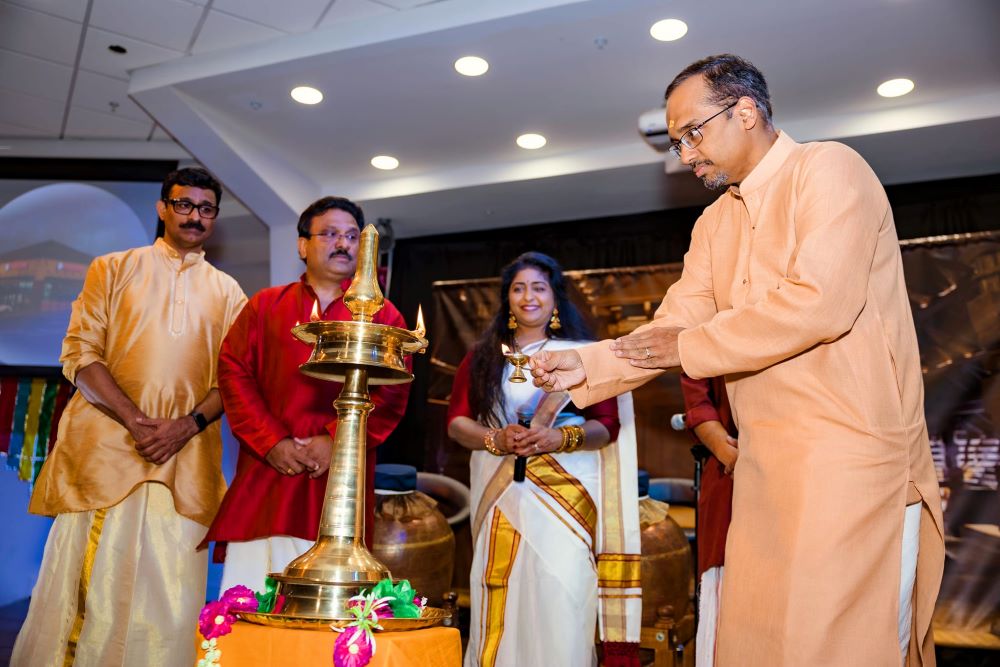
“It was my pleasure to organize and coordinate this wonderful event that highlights the traditional dance form of Kerala. I truly appreciate the support and encouragement of our Consul General, Dr. Swati Kulkarni,” Mini Nair, who co-organized and coordinated the event said. Nair also served as a gracious and vivacious anchor, elaborating the significance of the dance form at each stage of the performance. Rajeev Menon, Shajeev Padmanivas, Ranjit Gangadharan, Rajesh Pillai, and Rakesh Nair strived to coordinate the event in Atlanta.
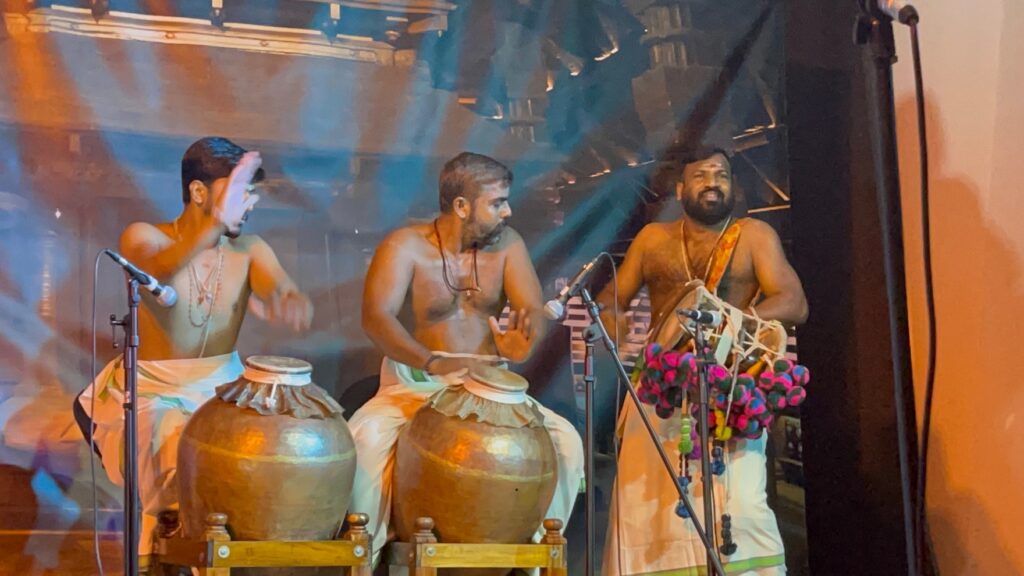
“Hindus of Georgia is a non-profit organization created to promote all temple art forms and organize programs to preserve, promote and enhance Sanatana dharma-based tradition, education, culture & heritage,” said co-organizer Rajeev Menon. “We are planning to bring many such programs like Kathakali in the near future, to create awareness in the younger generation about our traditional and ancient art forms.”
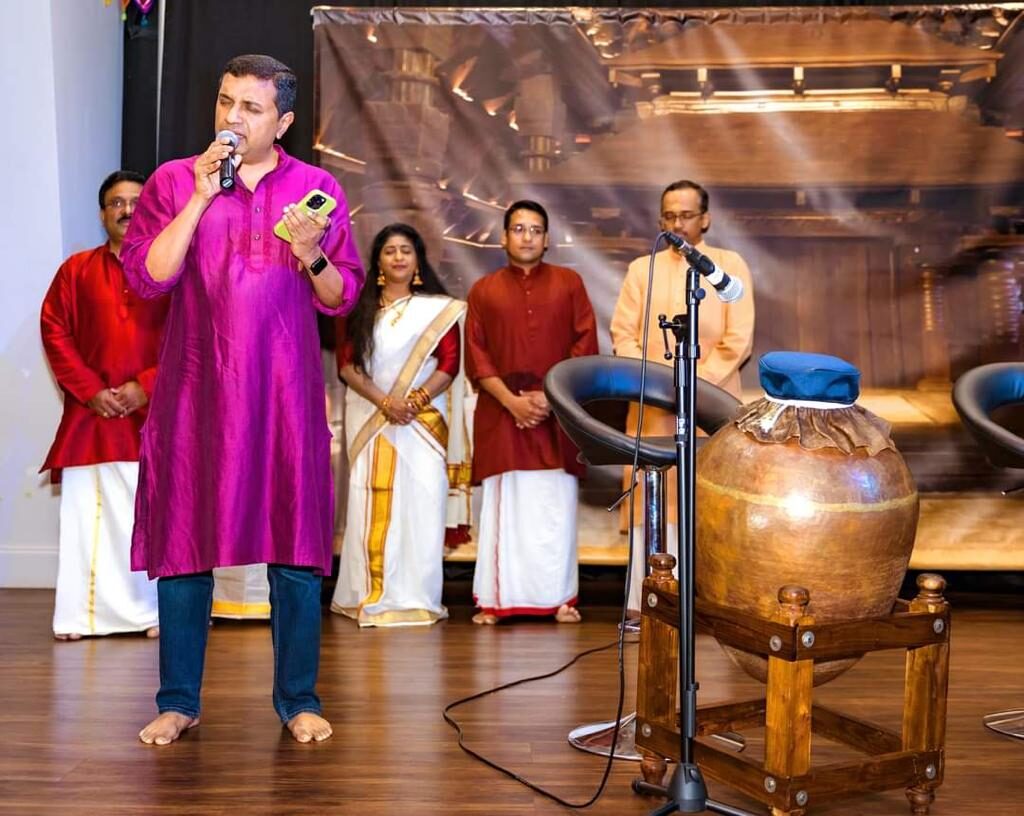
Koodiyattam
It is the oldest existing classical theatre form in the world, having originated much before Kathakali and most other theatrical forms, considered to be at least 2000 years old. Varma Cheraman Perumal, an ancient King of Kerala was known as the creator of Koodiyattam in the present form. His book “Aattaprakaram” describes various aspects about how to perform Koodiyattam. To date, this is considered the most authoritative work on the art form. The “grammar” of performance is entirely based on the stipulations of “Natyashasthram” by Bharatha Muni, the most authoritative book on the science of acting.
The word Koodiyattam literally means “acting together”. There are four methods or types of acting has been mentioned in Sage Bharata’s Natya Shastra – aangikam (expression using different parts of the body), vaachikam (expression through speech), sathvikam (expression of physical reactions to emotions) and aahaaryam (expression through costume, ornaments and props) are all woven into Koodiyattam performances. A typical Koodiyattam performance involves elaborate and lengthy acting sequences using hand gestures and distinctive modes of acting like Ilakiyaattom, Pakarnnaatttom and Irunnaattom.
In the olden days, Koodiyattam was not accessible to anyone except people from the brahmin and other similar ‘higher’ castes, and restricted to the temple as sacred art. Until the 1950s, Koodiyattam was performed only by men of the Chakyar community and women of the Ambalavasi Nambiar community in sacred theaters, called Koothambalam, on the grounds of the Hindu temples of Kerala. Koothambalam (“temple theaters”), special theater halls for Koothu and Koodiyattam performances, were constructed on temple grounds according to the specifications of Bharata Muni’s Nātyasāstra and considered to be as sacred as the temple sanctum itself.
Temple theatres called Koothambalam are permanent theatre structures attached to some of the major temples of Kerala. Considered ‘panchaprasada’, one of the five structures inside the temple complex, these were presumably constructed between the 12th and the 17th centuries. There are Kuttampalams in the temples in Thrissur, Guruvayoor, Irinjalakkuda, Kidangur, Thrippunithura, Chengannur and Harippad. In recent times, a new one was added in the premises of Kerala Kalamandalam, a major art institution devoted to classical arts in Kerala.
Makeup and Costumes in Koodiyattam
The ritual application of Aharya Abhinaya (makeup) is used to create an outward expression of each character’s complex inner qualities. The costumes have a blend of vibrant colors, predominantly red, black and white. The symbolic use of color is meant to make a statement. The makeup of most characters contains both black, representing “evil” and “paccha” (green) which roughly translates as “good”, in different proportions. The costume of the ‘vidushaka’ (jester) sets him apart from the rest. He has specialized makeup, small headgears and costume that vividly display his clownish facets.
Artists Kalamandalam Jishnu Prathap Kalamandalam Sangeetha, Kalamandalam Ratheesh Bhas (Mizhavu Artist), Kalanilayam Rajan, Kalamandalam Vijay, Saneesh C K, and Sreejith P.S brought alive the sequence of Balivadham – the Killing of Monkey King Bali, a significant episode in the epic Ramayana.
The plot involves brothers Bali and Sugreeva. Lord Surya’s charioteer Aruna who assumes the forma woman begets a child, Bali, from Lord Indra and one from Lord Surya, Sugreeva. Bali becomes the King of Kishkindha, land of monkey men.
He is challenged to a fight by a demon/magician Dundhubhi. They fight inside a cave for days and nights. Bali’s brother Sugreeva waits for him outside the cave. Dundhubhi, with his magic makes Sugreeva believe that Bali has been defeated and killed. Sugreeva closes the opening of the cave so that Dundhubhi may not escape, goes back to the Kingdom and takes over the throne and the queen.
Bali after killing Dundhubhi, realizes that the cave has been shut from the outside by his brother. He misunderstands that his beloved brother has tried to cheat him. Enraged he goes back to the kingdom, throws his brother out and regains the throne.
Sugreeva takes refuge in Rissyamukha mountains, where Bali cannot enter due to a previous curse from Sage Mathanga. During this time, Sugriva and his minister Hanuman meet Rama and they make a pact to help each other by which Rama would kill Bali and Sugreeva would become King again and then Sugreeva would help to find Rama’s wife Sita who has been abducted by Ravana. Rama follows Sugreeva to Kishkintha. Sugreeva and Bali engage in a fight during which Rama shoots Bali from a hiding place.
Koodiyattam is the art of elaboration of action through
extending the performance to unbelievable heights of imaginative extravagance.
With the background of the waring brothers, the Balivadham act zoomed in
Sugreeva challenging Bali to a war. Bali’s wife Tara tries to stop him,
suspecting Sugreeva and advising Bali to consult his ministers. A defiant Bali
ignores her plea, saying he does not fear anyone, including if Lord Vishnu
incarnated as Narsimha comes to fight him. At this point the actor enacted the
killing of King HiranyaKashipu by Lord Narasimha, thereby elaborating the
situation and poetic richness and drama to unearth the multiple layers of
meaning embedded in the text of the play, bringing its rasa(essence) to full
ripeness. I did not need to physically see blood as the actor depicted the
slaying of the evil king and Lord Narasimha drinking his blood from the chest!
The Narasimha Avatar is forever etched in my memory!
A rasa in Indian performing arts is a feeling or emotion that the art elicits
in every spectator. There was not a dry eye in the hall during the final act
in which Rama’s arrow striked Bali and he spends his last moments with his
brother.
The detailed evocation of each Rasa was complimented by the beats on the mizhavu building up an aural sculpture energizing the actors. The Nambiars for the night provided an aesthetic profundity to every scene in Koodiyattam by means of their astute playing of the mizhavu in all its subtleties.
Nangiar Koothu
Nangiar Koothu, a sister-form of Koodiyattam, is traditionally performed by Nangyars, the female members of the Nambiar community, in designated temples, in Kerala. The subject matter of the performance are verses from ‘Sree Krishna Charitam’, the story of Lord Krishna. During the performance, a single actress assumes the roles of various characters in the narrative and enacts the story through a highly formalized system of hand gestures, expression of ‘rasa'(emotion), recitation of verses and some unique stage techniques. The performer is accompanied by a Nambiar on the Mizhavu (copper pot drum) and another Nangiar on the ‘hollow’ cymbals.
Poothana Moksham
Poothana lives in popular imagination as a female demon, painted in black. But as the actor enacts the role of Poothana, she is an embodiment of all that could be a woman, both the positive and negative aspects. Poothana who is a demoness, intrinsically evil, assumes the beautiful form of a woman, with beauty on the outside and beast on the inside. Kamsa has decreed that she kill all the new-born boys, especially Gopala Krishna, who Kamsa believes will kill him in the future. She devices a plan to kill baby Krishna by rubbing poison on her breasts. But Little Krishna drinks the poisoned milk from her bosom and continued drinking until finally blood oozes out of her breast. Poothana shrieks in agony, waving all caution to winds. And in death she finds her blessing, liberation, her moksha.
Poothana in her earlier birth is said to be a pious lady and had become demon as a result of a curse. By getting killed by Krishna she was relieved of the curse and she attained Moksha.
The actor’s highly dramatic rendering was enhanced by the most musical of percussion instruments. The complexity of the mudras offset by the simplicity and depth of varied emotions that we encounter both in art and life was aesthetic pleasure.
Chakyar Koothu
Chakyar Koothu is primarily a type of highly refined monologue where the performer narrates episodes from Hindu epics (such as the Ramayana and the Mahabharata) and stories from the Puranas. Sometimes, it is also a traditional equivalent of the modern stand-up comedy act, incorporating commentary on current socio-political events (and personal comments directed at the members of the audience). “Koothu” means dance which is a misnomer, as facial expressions are emphasized and there is minimal choreography. It is a solo performance, by a narrator in distinctive headgear and black mustache with his torso smeared with sandalwood paste and red dots all over the body. The headgear resembles a snake’s hood, to symbolize the narration by Anantha, the thousand headed serpent.
The rhythms of Mizhavu drums and the characters portrayed by the supremely talented artists is etched in my memory forever. Kudos to Kerala Kalamandalam for preserving the fire and spreading it across nations. This one deserves its place in the theatrical history of the world.





